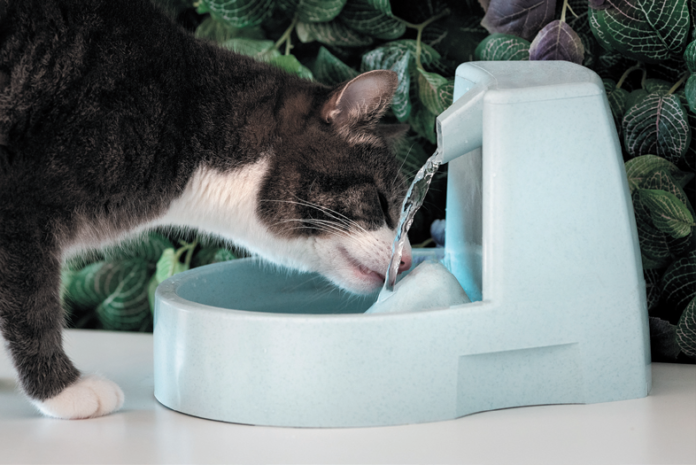Most of the time you don’t need to worry about whether your cat is drinking enough water. Setting out a bowl for her is usually enough. But a number of medical conditions increase a cat’s water requirement. One of them is kidney disease. Cats with kidney disease aren’t able to concentrate their urine as much as they should, and they urinate more frequently to rid their bodies of toxins. This can lead to dehydration.
Cats who are prone to bladder stones may also need to drink more water to keep their urine dilute enough so that stones don’t form. Additionally, extra water may be useful for flushing out the urinary tract when a cat has a disease affecting that part of the body. But if your pet’s veterinarian tells you to increase her water intake, how do you do it? It’s not like a cat necessarily feels more thirsty when she requires more water. Here are some tips.
- Try canned food. If your cat already eats canned food, great. It has a much higher water content than dry kibble. Some cats will even tolerate a little water added to their canned food to make it more of a slurry. If your pet is used to dry kibble, you can try to gradually switch her dry food for canned over a week’s time. (But if your cat simply refuses to eat the wet food, don’t try to force it. Go back to dry. A cat needs her calories, especially if she has a medical condition.)
- Try adding water to dry food. While some cats may not be willing to switch to canned food, they might be okay with you moistening a dry diet. Add some water little by little. But again, if your cat refuses the altered food, stop putting in water. Cats who refuse food for more than even a couple of days can get quite sick.
- Try adding broth to the dry food. Run this by your vet to make sure the particular broth you have in mind doesn’t contain too much sodium or any other ingredient, but a fish or meat broth dribbled over your cat’s food might encourage her to consume more fluid.
- Keep the food and water bowls separate. One theory says that if you put the food and water bowls side by side, a cat will be more enticed to drink once she has eaten. Another says that cats like their water bowls placed away from their meals. Most people do keep the two bowls side by side. See if separating them leads your cat to drink more.
- Place a few water bowls in different locations around the house. Can’t hurt, right?
- Fill a wide water bowl to the top. A cat’s whiskers are very sensitive to touch. She may not want to have to dip them into the bowl or scrape them along the edge to get the water into her mouth.
- Wash the water bowls every day. Would you fancy drinking from the same glass day after day without washing it? Cats are quite fastidious, so imagine what that must feel like to them. You may also want to change the water more than once a day to keep it cool and refreshing.
- Invest in a cat-sized water fountain. To a cat, standing water may be seen as stagnant and therefore unappealing. A battery-operated water fountain for pets that is constantly flowing may be just the thing to awaken her thirst.





I WANTED TO REEAD THE ARTICLE ABOUT CATS DRINKING WATER BUT AM UNABLE TO FIND IT IN AUGUST ISSUE PLEASE EMAIL IT TO ME ASAP. YR NEWSLETTER IS DISAPPOINTING IN THE ISSUES
I THI NK ARE NOT ADDRESSED IN DETAIL FOR 80 YRS LIKE ME HELP.
wIDGIT WELL NOT DRINK WATER DESPITE NUMEROUS FOUNTAINS PURCHASED.
SHE I IS JUST OVA CRYSTALS
Patricia, do try placing several water bowls around her living space, including one or two up high on any surface she frequents – like a window sill, table, desk, or counter top. My 14 year old Bengal readily drinks from these bowls in unusual places, but when I give her water by her food bowls she only drops her toys in it. So please give this a try – you might be happily surprised at her reaction.
I’ve been able to supplement my feral cat’s diet with more fluids by mixing in organic bone broth (with no additives) to her favorite paté canned food and warming up the soup-like mixture in the microwave.